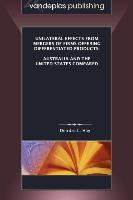- Start
- Unilateral Effects from Mergers of Firms Offering Differentiated Products: Australia and the United States Compared
Unilateral Effects from Mergers of Firms Offering Differentiated Products: Australia and the United States Compared
Angebote / Angebote:
This book considers how courts and regulatory agencies in Australia and in the US can and should assess mergers of firms which produce products or services differentiated in the minds of consumers from other products or services. (Most if not all products and services are differentiated at least to some degree so the topic is relevant to most mergers.) This book seeks the best solution for Australia to the difficulties posed by such mergers. It does so by comparing the approach taken in Australia with that taken in the US.
In the US, the main method of merger analysis where there are differentiated products is to consider whether the merger of two firms will create unilateral effects i.e., higher prices, by eliminating the constraint each firm places on the other. In Australia, Courts and the Tribunal, and until recently the Australian Competition and Consumer Commission (ACCC), have not emphasized unilateral effects. Comparatively little use has been made in Australia of economic methods (developed in the US) to isolate and predict unilateral effects of a merger.
This book is timely in light of the ACCC's recent Public Competition Assessment in Woolworths Limited - Proposed Acquisition of Kmart and Officeworks from Coles Group Limited in which the ACCC stated explicitly it performed a unilateral effects analysis, and because the Australian Merger Guidelines are likely to be amended soon to include a new section on unilateral effects analysis.
Part I defines and explains the significance of product differentiation and how it can lead to unilateral effects. Part II analyses the US approach to predicting the unilateral effects of mergers of firms producing differentiated products. Part III considers how mergers of firms that produce differentiated products and unilateral market power are analysed in Australia. Part IV compares the two jurisdictions. It summarises the problems and insufficiencies of the current Australian approach and the benefits of the US approach, and concludes that the Australian Courts (and to a lesser extent the ACCC) are insufficiently emphasising unilateral effects in predicting the effect of mergers of firms producing differentiated products. It recommends that unilateral effects analysis should be used in Australia to augment the current Australian approach to merger analysis, the Australian Guidelines should be amended, and US economic methods should be used to predict unilateral effects.
About the author:
Dr. Deirdre Hay is at the law firm Harris Beach PLLC, Ithaca New York. She does antitrust work and represents financial institutions in banking and real estate transactions. She has considerable experience in antitrust counseling, transactional, and litigation matters in both the US and Australia and has practiced intellectual property law in Australia. She has represented international clients before the Department of Justice, the Federal Trade Commission, and Australian Competition and Consumer Commission. Dr. Hay was involved in the successful Full Federal Court appeal, News Limited v. Australian Rugby League Ltd. (1996) 64 FCR 410 (Superleague Appeal), Multigroup Distribution Services Pty. Ltd. v. TNT Australia Pty. Ltd. and Ors., Trade Practices Commission v. Australian Feather Mills Pty. Ltd. (1989) 26 FCR 555, as well as the deregulation hearings for Pennsylvania Power & Light. Dr. Hay is an editor of the American Bar Association's Antitrust Law Journal and has served as Managing Editor.
Fremdlagertitel. Lieferzeit unbestimmt
